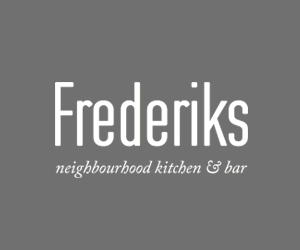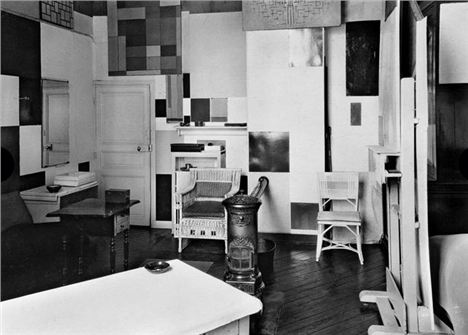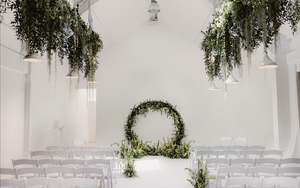YOU know instantly when you see a Mondrian: the black grid lines, the oblong and square blocks of pure colour in odd places, the total focus on minimalist abstraction.
Mondrian's style is universally recognised and became his trademark. It is both graphic and painterly and admired by artists of both traditions for its crisp and clean application. Where Picasso and Braque had Cubism, Mondrian dispensed with one aspect of it in order to direct his energy to the two-dimensional plane.
You won’t find any evidence of the use of masking tape – each line-edge has been expertly executed by hand and there’s no sign of bleed between the colour blocks. It was an obsession - obsessive compulsive even
However Piet Mondrian’s legacy goes far beyond the art world and has permeated into fashion, design and music. From Alexander McQueen’s spring/summer 2014 collection and Yves Saint Laurent’s ‘Mondrian’ day-dress, to the use of his Neo-Plasticist style by The White Stripes for the cover of their album De Stijl in 2000, the Dutch artist has made a significant impact on today’s visual landscape with an influence that certainly helped to sow the seeds for the more-or-less universal design aesthetics which first originated in Habitat and is now commonly found in IKEA home furnishing.
 Mondrian In His Studio In Paris 1933
Mondrian In His Studio In Paris 1933
This exhibition down in the Albert Dock has both national and international significance. Not only does it coincide with the 70th anniversary of the Dutch painter's death but also gathers together the largest number of his works ever assembled in the UK, and includes a reconstruction of his Paris studio to experience how his art and life seemed to fuse into a thematic whole. It’s a comprehensive overview, going back to his initial venture into Hague School impressionism and spans an extensive body of work up to his move to New York at the end of his life.
This enabled Mondrian to focus on his obsession geometric precision interspersed with blocks of primary colour. There’s hardly any use of the golden mean, nor willingness to create a sense of innate balance. It’s about as clinically abstract as you can get – all achieved with a singular dedication to well-defined accuracy of line. Considering that the majority of work is oil on canvas, it’s an impressive accomplishment. Unlike the present-day, you won’t find any evidence of the use of masking tape – each line-edge has been expertly executed by hand and there’s no sign of bleed between the colour blocks. Like I said, it was an obsession - obsessive compulsive even.
In terms of early influences, there’s an indication of urbanism in Scaffold Study for Tableau III which shows how he became interested in the relationship between juxtapositions of line. It could quite easily be a cross-section of the inner workings of his head.
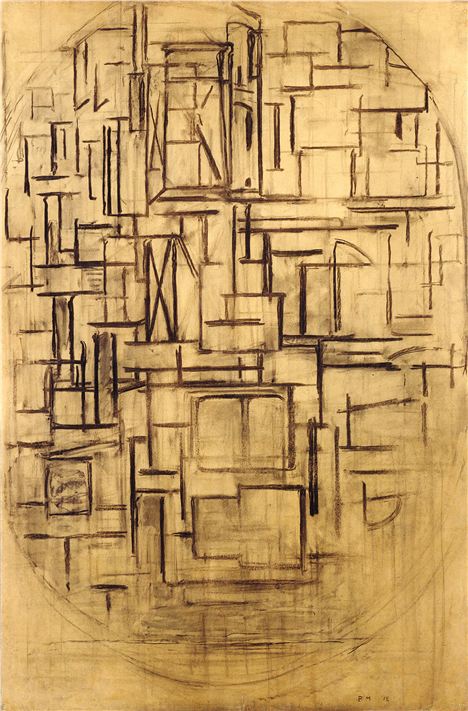 Scaffold Study For Tableau III
Scaffold Study For Tableau III
Also, around this time, Mondrian became involved with the Dutch branch of the Theosophical Society with a particular spiritualist dimension. One could argue that this may explain his almost hermit-like lifestyle, but however you look at it God was in the detail. Similarly, he began to experiment with the use of random colour blocks within a proto-grid structure in Composition in Colour B. These early efforts enable us to see the gradual evolution of his idiosyncratic style.
Interestingly, this took on a life of its own beyond the canvas. When Mondrian moved to a new studio in Paris in 1911 [26 Rue du Depart to be exact], he created a living/working space which reflected a desire to exist within the abstract world itself. The reconstructed studio is a major achievement for this exhibition, down to the finest details including his glasses and pipe. A rare photo shows him besuited and aloof looking more like a civil servant than his more bohemian contemporaries. There’s no paint-spattered floor, no pots of paint or jars of white spirit to be seen. Again, it’s clean, crisp and clinical to a remarkable degree, as evident in one of his early neo-plastic works No_ VI Composition No_II.
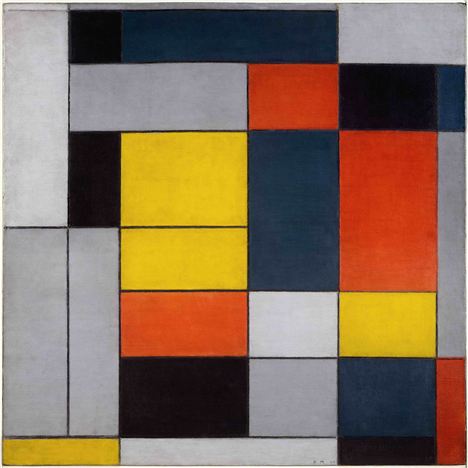 Piet Mondrian - No_ VI Composition No_II
Piet Mondrian - No_ VI Composition No_II
This phrase (neo-plasticism) doesn’t really attempt to either justify or explain Mondrian’s mindset but had a great influence on the emergence of De Stjil as a proto-movement with links to the Bauhaus and Russian Constructivism. In this context, both architecture and furniture design took on the mantle of avant-garde pioneers. Mondrian found himself at the epicentre of this movement as the chief propagandist in paint during the 1920s. Just as he imagined his studio to be a dynamic environment, Mondrian rejected the idea of static forms of balance and harmony in his paintings.
To reinforce this, he began to use the phrase "dynamic equilibrium" which, at first glance, is a paradoxical way of justifying his individual style. It's easier to understand as a "perpetual movement of changing oppositions".
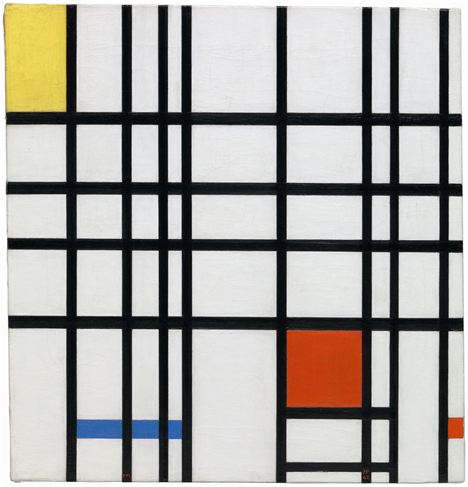 Piet Mondrian - Composition With Yellow, Blue And Red 1937- 1942
Piet Mondrian - Composition With Yellow, Blue And Red 1937- 1942
So, as evident in his most celebrated work, Composition with Yellow, Blue and Red, much emphasis is placed on the juxtaposition of primary colours within the grid schema. It’s both contemplative and cool, devoid of any meaning outside itself…art for art’s sake to the max.
Overall, Mondrian embodies a particularly unique place in the abstract movement which found resonance with British artists like the Nicholsons. Later, this would emerge through Bridget Riley and some of Damian Hirst’s recent colour spectrum work.
Lastly, there’s a final reference to his output during the early 1940s in New York in his unfinished Victory Boogie Woogie (main image, top) which, although the original was too valuable to exhibit, indicates that he was embarking on a fresh synthesis of diagrammatic patterns in an attempt to push forward the boundaries of abstraction and colour correlations yet again.
Yet, no matter how abstract, the popular appeal of Mondrian's lines will be enough to reel them in at the dockside for months to come.
8/10
*Mondrian and His Studios, Tate Liverpool, Albert Dock, until October 5.
Talks and lectures
Mondrian group tour
Daily: Monday - Friday 12.00; Saturday and Sunday 12.00 & 15.00
Philosophy in the gallery: Mondrian and his Studios
Thursday 19th June 2014, 17.30 – 19.00
Mondrian the man
Friday 27th June 2014, 14.00 – 15.00
Curator-led guided tour
Thursday 18th September 2014, 15.00 – 16.00






